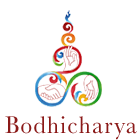What Is Dharma?
These three days of teachings on the topic “What Is Dharma?” took place in the shrine room of Bodhicharya Berlin with a German translation. Other languages (French, Portuguese from the 2nd session onwards) were done on Zoom.
Session 1
The 10 meanings of the Sanskrit word ‘dharma’. Dharma as the enlightened experience and the teachings to attain that. Why and how Prince Siddhartha became the Buddha and how he has taught others to attain the same. Buddha’s sangha did not follow the caste system of that time; anybody can attain the enlightened experience if they really practice the dharma.
Session 2
Buddhism is a religion, but it’s different from most of the other religions in that it’s completely focused on human and not on God. The quintessence of the dharma is the 4 Noble Truths: finding the way to solve our problems once and for all. The cause of our problems is our negative emotions. Working on those is the whole practice of dharma. Nobody else can do it for us, we have to do it ourselves.
Session 3
Because there are different beings, different stages and different cultures, Buddha gave 84 000 different teachings, which can be categorized as different yanas. Each person should find their own best system but respect all others as well. Just like I have a lot of negative emotions and problems, so does everybody else too. In order to improve, I must first fully accept the way I am, and rejoice in even the smallest improvement I can do. There are 3 necessary causes of negative emotions: 1. The root cause is not eliminated 2. Provocation. 3. Wrong way of seeing. What we all can work on is the third. Dharma as the path then has 3 trainings, which are all interconnected: 1. Shila (to know what is good to do or not to do, and allow myself act accordingly) 2. Wisdom (through study and reflection) 3. Meditation (can be very simple, like counting 21 breaths).
For more information, visit: https://bodhicharya.de

